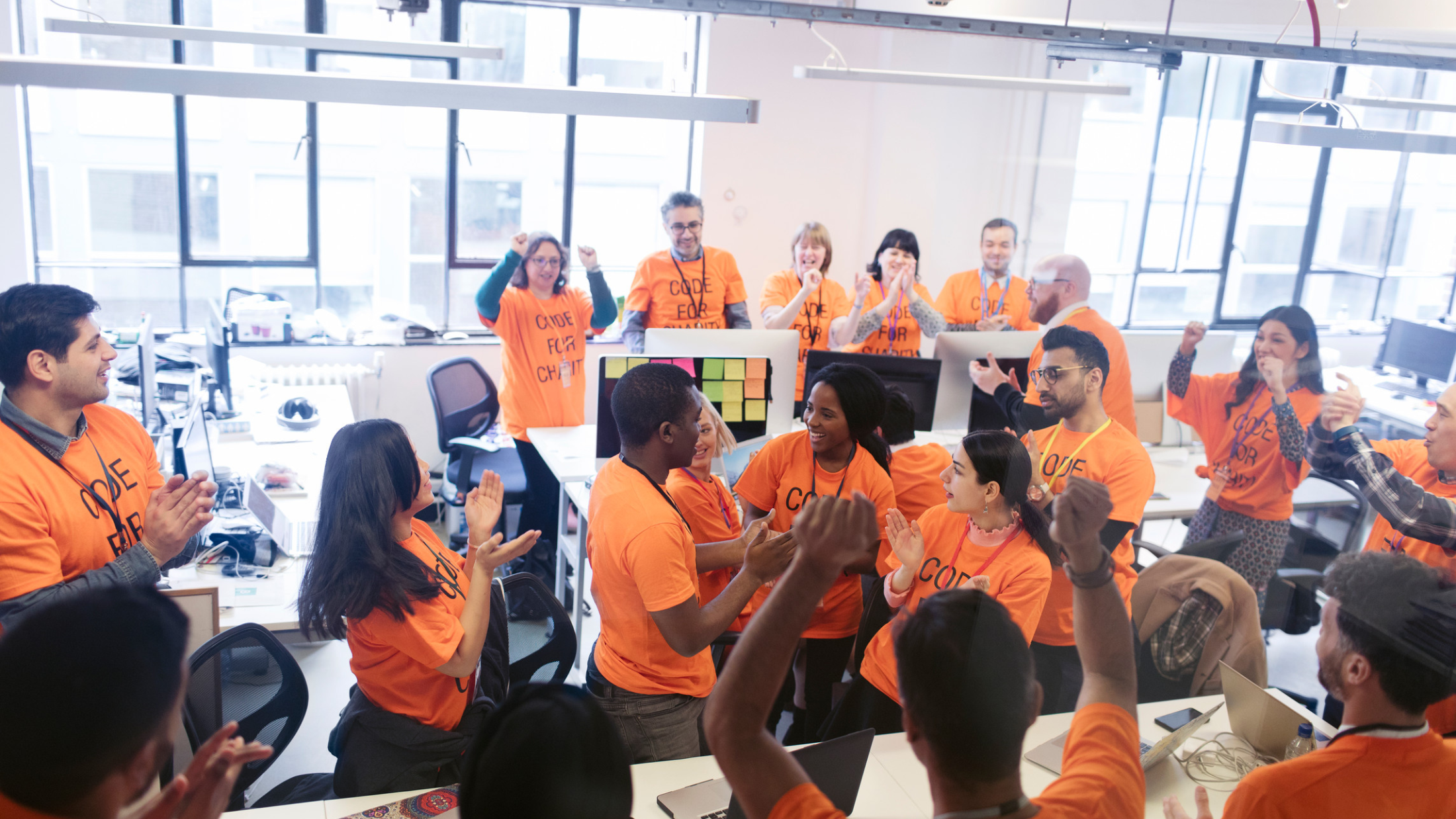Developers are notoriously allergic to traditional marketing tactics. Their trust lies in genuine value, not flashy campaigns. One powerful way to provide that value is by building a community around your tool or field of expertise. But building an engaged community is hard – it’s a long-term effort demanding significant commitment and a well-defined strategy.
Last month, we tackled this challenge in our webinar, “Cultivating a Thriving Developer Community.” Joined by community champions like Rebecca Marshburn (Head of Community at Common Room), Ron Northcutt (Head of Developer Relations at Appsmith), and Tessa Kriesel (DevRel Leader & Coach), we explored the main ingredients for fostering a developer community that drives business success.
This blog post distills the webinar’s key insights and strategies for starting, building, and measuring your developer community’s success.
What Is A Developer Community?
At its core, a developer community is a group of developers who share a common interest. This interest could be a specific programming language, a particular technology stack, or even just a general passion for software development. Engaged developers who find value in the community are more likely to become paying users of your product.
Ron Northcutt offered a broader perspective on developer communities. With a background in open-source, he sees a developer community as encompassing a wide range of audiences, including those who have simply heard about the product, those who use it occasionally, and those who are deeply engaged members. External channels like Reddit can be valuable tools for attracting developers to a more focused community platform.
Types Of Developer Communities
Now that we understand the core concept, let’s explore the various forms developer communities can take:
Internal Developer Communities
These communities exist within a single company and cater to two distinct audiences:
- Internal Developers: These are the developers who build and maintain the company’s own products. A strong internal developer community, as Rebecca mentioned, is necessary for improving communication, collaboration, and knowledge sharing within your organization.
- Customers: These are the developers who use your product. An internal developer community can be a valuable space not only to share best practices, and troubleshoot issues, but also to get product feedback.
External Developer Communities
External developer communities are open to everyone and can be centered around a specific product, technology, or simply a shared interest in software development. It’s important to distinguish these communities from audiences on platforms like Reddit. As Tessa Kriesel pointed out, these platforms are more like channels for information sharing and discussion, not true communities that foster a sense of belonging and deeper connections.
Community of Practice vs. Community of Product
While the above categories provide a foundational understanding, developer communities can also be classified based on their focus:
- Community of Practice: These communities center around a shared field or practice (e.g., data management, mobile development). Members exchange best practices, troubleshoot challenges, and learn from each other’s experiences.
- Community of Product: These communities revolve around a specific product or tool. Users gather to learn its functionalities, share success stories, and get support from the product team or fellow users.
Many communities blend these approaches. This allows them to attract developers interested in the broader practice while also catering to those who use their specific product, which can be particularly beneficial as members can learn about the field and discover a valuable tool to enhance their work.
The Developer Journey & How They Reach Your Community
Imagine a developer on a quest to find the perfect tool for their project. Their journey likely starts with a broad search, then narrows down as they explore options and deepen their understanding. Your developer community can be a powerful destination on this journey, offering valuable resources, support, and connections.
But how do developers actually find their way to your community? To understand this, let’s explore the concept of community growth types and how they align with the developer journey.
First, we can think of two growth options: organic and intentional.
- Organic Community Growth: Imagine a developer stumbles upon your product on Reddit during their initial discovery phase. This exposure, while valuable, might not necessarily translate into them joining your dedicated community platform.
- Cultivated Community Growth: By understanding the developer journey and the different stages (discovery, evaluation, learning, adopting), you can strategically guide developers toward your community. This cultivated approach can involve creating valuable content, engaging on relevant platforms like Reddit, and providing clear pathways for developers to find your community.
Then, we can map our growth method together with the developer or community stages, guiding developers through a series of steps within your community and offering targeted resources and experiences based on their current stage and needs.
Tessa Kriesel emphasized that during the discovery phase, external communities like Reddit might be a good fit. As developers progress through the stages, they can be nurtured towards your more focused community platform.
💡Read the book How to Build and Grow a Successful Developer Program to learn more about the developer journey map.
Rebecca Marshburn offered a model with three community stages:
- Tertiary Community: This is the broadest stage, encompassing anyone who has heard about your product or could potentially benefit from it.
- Secondary Community: This stage includes developers who are interested in your content or resources, such as following you on social media or checking out your GitHub repository.
- Primary Community: This is your core community, where developers are actively engaged with your product and participate in discussions and collaborations.
Both perspectives emphasize the importance of understanding the stages developers go through and strategically guiding them toward your community at the most relevant points. Understanding the developer journey and strategically guiding them through the different stages can help you build a thriving community that benefits both developers and your business.
First Steps of Building a Community
Before you start considering building a developer community, there are two important foundation steps to consider:
1. Know Your People
As Rebecca emphasized, the cornerstone of any successful community is a deep understanding of your target audience. Regardless of the size of your initial community, take the time to truly understand their needs, motivations, and pain points.
Some of the key questions to consider are:
- What are their challenges? Identify the problems your developers face and how your product or service can help them overcome those obstacles.
- What kind of content do they value? Understanding their preferred learning styles and content formats will guide your content creation strategy.
- What makes them feel valued and appreciated? Recognize and acknowledge their contributions to foster a sense of belonging and encourage participation.
These evaluative questions will help you to:
- Develop targeted content and resources that address their specific needs and interests.
- Craft a welcoming and inclusive community experience that resonates with your target audience.
- Empower your developers to co-create valuable content through collaborations and knowledge sharing.
2. Align With Your Business Goals
Before embarking on community building, it’s essential to align with your internal stakeholders, as Tessa mentioned. Take a step back and consider the bigger picture: what are the overall business goals for your developer community?
- Get to know your stakeholders: Familiarize yourself with the needs and priorities of different departments, such as sales, marketing, customer success, and recruiting.
- Align with business objectives: Understand how your community can contribute to achieving broader company goals.
- Identify success metrics: Collaborate with your stakeholders to define measurable metrics for tracking the success of your developer community.
How To Measure Success?
Measuring the success of a developer community is probably the hardest aspect of any developer relations department. As Ron Northcutt highlighted, it’s challenging because DevRel efforts serve various stages of the developer lifecycle. You might create a blog post that a developer uses to solve a problem for free, or you might nurture a student who becomes a brand advocate years later. Both interactions contribute to the community’s value, but tracking their impact on the business can be difficult.

Here are some key tactics that can help you start measuring success:
Define Short-term and Long-term Goals
Rebecca offered a helpful framework for navigating this challenge by considering both short-term and long-term goals.
- Short-Term Goals: Focus on aligning with stakeholder needs. Identify your Ideal Customer Profile (ICP) and develop strategies to attract them to your community. Metrics like community growth and engagement among relevant developer personas can indicate short-term success.
- Long-Term Goals: Look beyond immediate conversions. Building a thriving community fosters brand loyalty and creates a pool of potential customers who are already familiar with your product’s value. Tracking how your community attracts industry influencers or future decision-makers demonstrates the long-term impact.
Find the Right Data & Tools
Imagine being a chef who can’t taste their own food. That’s what it can be like without data in DevRel. Tessa Kriesel highlighted the importance of data in gauging the effectiveness of your DevRel programs, but she also acknowledged the challenges of accessing the right data or using tools that collect and analyze relevant metrics effectively.
The key metrics in building and growing a developer community that you should track are:
- Activity Tracking: Look for solutions that track user activity within your community platform. This data can reveal how developers are engaging with your content and resources, providing valuable insights into their interests and needs.
- User Journey Tracking: Understanding the complete user journey, from initial touchpoints to conversions, can help you attribute the impact of your community efforts. Tools that connect community activity with sales pipelines can demonstrate the value DevRel brings to the broader business.
Conclusion
Building a successful developer community hinges on three key pillars: a deep understanding of your audience, tailoring your approach to the developer journey stages, and continuously measuring impact.
As Ron Northcutt pointed out, the tech sales landscape has shifted. Contrary to the past decades, prospects now often conduct extensive research before even reaching out to ask a question. This means that capturing data during the early research phase is crucial for understanding what resonates with developers and identifying areas where your community content or resources might be lacking.
Prioritizing genuine value over marketing tactics remains the key takeaway in community building as well as developer marketing in general. This translates into more than just brand loyalty and fosters a powerful ecosystem that generates valuable leads for your business.
Ready to dive into more DevRel and Developer Marketing insights? Join our upcoming webinars for expert insights and live sessions packed with knowledge from industry leaders.

